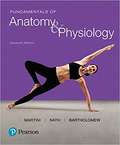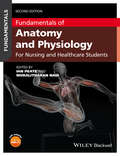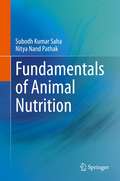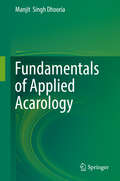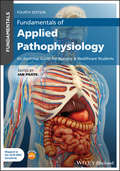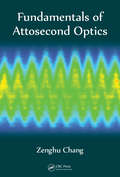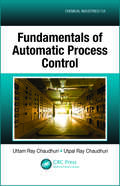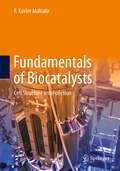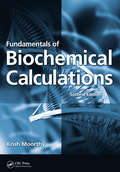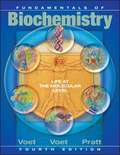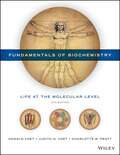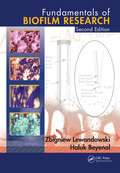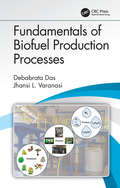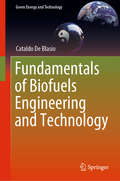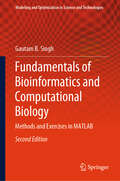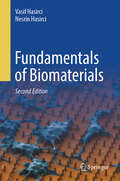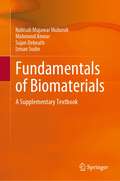- Table View
- List View
Fundamentals of Anatomy & Physiology, Tenth Edition
by Edwin F. Bartholomew Frederic H. Martini Judi L. NathFundamentals of Anatomy & Physiology helps you succeed in the challenging A&P course with an easy-to-understand narrative, precise visuals, and steadfast accuracy. Every chapter of the Tenth Edition includes one- and two-page Spotlight Figures that seamlessly integrate text and visuals to guide you through complex topics and processes.
Fundamentals of Anatomy and Physiology
by Frederic Martini Judi Nath Edwin BartholomewFundamentals of Anatomy & Physiology helps students succeed in the challenging A&P course with an easy-to-understand narrative, precise visuals, and steadfast accuracy. With the 11th Edition, the author team draws from recent research exploring how students use and digest visual information to help students use art more effectively to learn A&P. New book features encourage students to view and consider figures in the textbook, and new narrated videos guide students through complex physiology figures to help them deconstruct and better understand complicated processes. Instructors can also request a new handbook by Lori Garrett, entitled The Art of Teaching A&P: Six Easy Lessons to Improve Student Learning , which explores some of the most common challenges encountered when using art to teach A&P, alongside strategies to address these challenges.
Fundamentals of Anatomy and Physiology (6th Edition)
by Frederic H. MartiniThis text shows students the links between normal anatomy and physiology and important disease states. In the process, it teaches basic diagnostic principles and develops critical-thinking skills. It includes An Introduction to Diagnostics, with discussion of the scientific method and the techniques by which diseases are detected and identified. It provides Applied Research Topics, with discussions of genetic engineering, pathogens and infectious diseases, and cancer formation and treatment. It also provides The Body Systems, clinical and applied topics, with discussions of diagnostic tests and representative disorders for each organ system in the body.
Fundamentals of Anatomy and Physiology: For Nursing and Healthcare Students (Fundamentals)
by Ian Peate Muralitharan NairFundamentals of Anatomy and Physiology for Nursing and Healthcare Students is a succinct but complete overview of the structure and function of the human body, with clinical applications throughout. Designed specifically for nursing and healthcare students, the new edition of this best-selling textbook provides a user-friendly, straightforward, jargon-free introduction to the subject. Key features: Clinical considerations and scenarios throughout showing how the material can be applied to daily practice Featuring over 300 superb full colour illustrations Now includes a boxed feature throughout on medicines management; providing information concerning a variety of medicines used in the care and management of people that are related to the body system of the chapter The 'Conditions' feature within each chapter provides you with a list of disorders that are associated with the topics discussed, helping relate theory to practice Each chapter includes learning outcomes, test your knowledge, scenarios, activities and summaries. Includes a list of prefixes and suffixes, as well as normal values, and a glossary of terms Supported by enhanced online resources with fantastic extras for both lecturers and students, including an image bank, online glossary, flashcards, interactive multiple choice questions, examples of patient notes, and more This edition is now supported by an accompanying study guide to facilitate the learning and revision of the content within this book: 'Fundamentals of Anatomy and Physiology Workbook: A Study Guide for Nurses and Healthcare Students'
Fundamentals of Animal Nutrition
by Subodh Kumar Saha Nitya Nand PathakThe book provides comprehensive information about the different aspects of veterinary nutrition in tropical countries.The introductory chapter discuss the importance of nutrition, feeds and feeding of balanced and optimum feeds specifically required for the sustenance of life. The second chapter, discusses briefly the history of research in animal nutrition.The book further talks about the relationship between the environment and nutrition in animals; the chemical composition of plants and animals; and the various sources of feed for animals. It provides details on the different phases of life cycle in animals, and the effect of nutrition on the performance. Various Nutrients and its importance in livestock nutritionand production has been illustrated in details. Various nutrients such as water, carbohydrate, protein, fats, vitamins, minerals etc are individually dealt in a separate chapter. The digestive system,digestion and metabolism of carbohydrates, protein and fats in ruminant and non ruminant livestock have been illustrated. A dedicated chapter fully describes the activity of enzymes which are directly involved in nutrition. Also this book deals with the harmful components of animal feed which are found mainly in the unconventional feeds. The books also provide chapters like partitioning of feed& energy and also the therapeutic and clinical nutrition which are very importantfor the under graduate & post graduate students and researchers of animal nutrition and livestock production and management. This book is useful for researchers, undergraduate and post graduate students studying veterinary sciences, animal husbandry, zoology and biochemistry.
Fundamentals of Applied Acarology
by Manjit Singh DhooriaAcarology - the study of mites and ticks, is a subdiscipline of Zoology, and is many times considered in the field of Entomology (the study of insects). Mites and ticks are distributed throughout the world and inhabit almost every ecosystem (both terrestrial and aquatic) including grassland soils. More than 55,000 species of mites and ticks are already described. Mites and ticks directly affects humans as pests of different crops, fruit plants, vegetable crops and field crops; as parasites of human beings, veterinary animals, poultry and pets; pests of stored grains and other products; mushrooms and cheese; and as parasites of honeybees. Mite infestations are responsible for economic losses worth billions of dollars in terms of reduced crop yields and lowered quality of produce. Many species of mites serve as vectors of various plant diseases; some species of ticks cause losses through blood feeding and by transmitting many diseases among man and animals. House-dust mite allergies, and tick bite allergies are also common in many parts of the world. Present Book, "Fundamentals of Applied Acarology," is written keeping in view non-availability of any standard text dealing in different aspects of acarology at one place. Separate chapters in this book are devoted to Importance of Acarology, Historical account, acarine technology, morphology and anatomy of Acari; Feeding, Development and Reproduction. Molecular developments in relation to mites and ticks are also discussed. Role of mites and ticks in Quarantines of plants and animals; forensic/criminal investigations; and importance of accidental acarophagy are discussed in detail. Safe usage of pesticides based on their mode of action (IRAC's Groups), development of acaricide resistance and measures to mitigate it are discussed. Mite pests of fruit trees, vegetable plants, and floricultural plants; field crops; mite problems in greenhouses/polyhouses; and mite problems encountered under organic cultivation of plants; and their management through minimum usage of pesticides are emphasized. Role of different predaceous mites in controlling plant pests like thrips, aphids and scale insects is elaborately discussed. Biological control of phytophagous mites is discussed in detail. Different animal parasitic mites and ticks are discussed from veterinary and medical point of view. At the end of each chapter, many important references for further reading; and Electronic References (ER) in the form of youtube links and other weblinks are given to understand fully how these tiny creatures look like; behave, feed and reproduce; nature of damage they cause to plants and animals; and measures to mitigate them. Weblinks will stimulate interest in the readers for more information about different mites and ticks. The knowledge contained in the book may prove as best material for "General and Applied Acarology" course for graduate and post-graduate levels, teachers and researchers in entomology, pest control advisors, professional entomologists, pesticide industry managers, policy planners, and others having interest in mites and ticks.
Fundamentals of Applied Pathophysiology: An Essential Guide for Nursing and Healthcare Students (Fundamentals)
by Ian PeateFundamentals of Applied Pathophysiology delivers a highly visual and accessible introduction to pathophysiology for nursing and healthcare students, guiding readers through the subject matter with case studies, exercises, key words, and additional resources to support learning and retention. The new edition of Fundamentals of Applied Pathophysiology includes brand-new content on homeostasis, systematic approach to assessment, and key terminology. The book features links to clinical observations, vital signs to observe, investigation boxes, clinical red flags, medication alerts, and the latest, contemporary evidence for care management, including National Early Warning Score 2 (NEWS2). Presents comprehensive treatment guidance for all fundamental pathophysiology categories, including disorders of the central nervous system, heart, vascular and renal systems, and more Aligns with the latest NMC standards Full-colour illustrations throughout that brings the subject to life Fundamentals of Applied Pathophysiology belongs on the bookshelves of all pre-registration nursing students, midwifery students, healthcare assistants, and assistant practitioners. Professionals in allied healthcare areas such as physiotherapy, radiotherapy, and occupational therapy will also benefit from the material contained in this comprehensive resource.
Fundamentals of Astronomy
by C BarbieriProviding a broad overview of foundational concepts, Fundamentals of Astronomy covers topics ranging from spherical astronomy to celestial mechanics, closing with two chapters that discuss elements of astronomical photometry and spectroscopy. Supplementary and explanatory notes at the end of each chapter provide references to material published in scientific journals, and solved and unsolved exercises allow students to review their understanding of the material. Broad in coverage, the book presents arguments from classical astronomy, such as spherical astronomy, that form the foundation for future work in the field. Features
Fundamentals of Astronomy
by Ivano Bertini Cesare BarbieriProviding a broad overview of foundational concepts, this second edition of Fundamentals of Astronomy covers topics ranging from spherical astronomy to reference systems, and celestial mechanics to astronomical photometry and spectroscopy. It expounds arguments of classical astronomy that provided the foundation for modern astrometry, whilst presenting the latest results of the very-long-baseline interferometry (VLBI) radio technique, optical interferometers and satellites such as Hipparcos and GAIA, and recent resolutions of the IAU and IERS regarding precession, forced and free nutation, and Earth figure and rotation. Concepts of general relativity are explored, such as the advance of Mercury’s perihelion, light deflection and black holes, in addition to the physical properties, orbits, and ephemerides of planets, comets and asteroids with an extension to visual binary stars orbital reconstruction. Extrasolar planets are also discussed, with reference to radial velocity and transits measurements by ground and space telescopes. Basic concepts of astronomical photometry, spectroscopy and polarimetry are given, including the influence of the terrestrial atmosphere. Classical works, such as Hipparchus, are mentioned in order to provide a flavor of the historical development of the field. It is an ideal textbook for undergraduate and graduate students studying astronomy, astrophysics, mathematics, and engineering. Supplementary and explanatory notes provide readers with references to additional material published in other literature and scientific journals, whilst solved and unsolved exercises allow students to review their understanding of the material. Features: Provides an introductory vision of arguments from spherical astronomy to celestial mechanics to astronomical photometry and spectroscopy Presents the information at an introductory level without sacrificing scientific rigor Fully updated throughout with the latest results in the field
Fundamentals of Astrophysical Fluid Dynamics: Hydrodynamics, Magnetohydrodynamics, and Radiation Hydrodynamics (Astronomy and Astrophysics Library)
by Shoji Kato Jun FukueThis book offers an overview of the fundamental dynamical processes, which are necessary to understand astrophysical phenomena, from the viewpoint of hydrodynamics, magnetohydrodynamics, and radiation hydrodynamics.The book consists of three parts: The first discusses the fundamentals of hydrodynamics necessary to understand the dynamics of astrophysical objects such as stars, interstellar gases and accretion disks. The second part reviews the interactions between gases and magnetic fields on fluid motions – the magnetohydrodynamics – highlighting the important role of magnetic fields in dynamical phenomena under astrophysical environments. The third part focuses on radiation hydrodynamics, introducing the hydrodynamic phenomena characterized by the coupling of radiation and gas motions and further on relativistic radiation hydrodynamics.Intended as a pedagogical introduction for advanced undergraduate and graduate students, it also provides comprehensive coverage of the fundamentals of astrophysical fluid dynamics, making it an effective resource not only for graduate courses, but also for beginners wanting to learn about hydrodynamics, magnetohydrodynamics, and radiation hydrodynamics in astrophysics independently.
Fundamentals of Astrophysics: Astrophysical Methods (UNITEXT for Physics)
by Attilio FerrariThis textbook introduces the reader to the study of astrophysics through a journey that spans the fields of physics, mathematics, and technology. Based on the author’s extensive teaching experience, it emphasizes the fundamental observational data and theoretical methods employed for constructing models of stars, galaxies, and large-scale structures in the universe. After an introduction outlining the historical development of universe studies, Part I delves into gravitational theories including basic general relativity and gravitational waves. Part II explores radiation and plasma processes crucial for interpreting observed data and modeling cosmic objects. Part III addresses the observational techniques essential in astrophysics, along with the analysis of astrophysical parameters obtained from photometry and spectroscopy.
Fundamentals of Attosecond Optics
by Zenghu ChangAttosecond optical pulse generation, along with the related process of high-order harmonic generation, is redefining ultrafast physics and chemistry. A practical understanding of attosecond optics requires significant background information and foundational theory to make full use of these cutting-edge lasers and advance the technology toward the n
Fundamentals of Automatic Process Control
by Uttam Ray Chaudhuri Utpal Ray ChaudhuriStrong theoretical and practical knowledge of process control is essential for plant practicing engineers and operators. In addition being able to use control hardware and software appropriately, engineers must be able to select or write computer programs that interface the hardware and software required to run a plant effectively. Designed to help readers understand control software and strategies that mimic human activities, Fundamentals of Automatic Process Control provides an integrated introduction to the hardware and software of automatic control systems.Featured Topics Basic instruments, control systems, and symbolic representations Laplacian mathematics for applications in control systems Various disturbances and their effects on uncontrolled processes Feedback control loops and traditional PID controllers Laplacian analysis of control loops Tuning methods for PID controllers Advanced control systems Virtual laboratory software (included on downloadable resources) Modern plants require operators and engineers to have thorough knowledge of instrumentation hardware as well as good operating skills. This book explores the theoretical analysis of the process dynamics and control via a large number of problems and solutions spread throughout the text. This balanced presentation, coupled with coverage of traditional and advanced systems provides an understanding of industrial realities that prepares readers for the future evolution of industrial operations.
Fundamentals of Bacterial Physiology and Metabolism
by Namita Gupta Rani GuptaThis book provides useful information on microbial physiology and metabolism. The key aspects covered are prokaryotic diversity, growth physiology, basic metabolic pathways and their regulation, metabolic diversity with details of various unique pathways. Another focus area is stress physiology with details on varying environmental stresses, signal transduction, adaptation and survival. For instructional purposes, the book provides case studies, interesting facts, techniques etc. which help in showcasing the inter-disciplinary nature and bridge the gap between various aspects of applied microbiology.
Fundamentals of Biocatalysts: Cell Structure and Function
by F. Xavier MalcataThis textbook covers the essentials of cells as biocatalysts, including cell morphology, cell genetics, cell metabolism, cell operation, cell stoichiometry, cell engineering, and cell interaction. A pragmatic and systematic approach is provided to all such topics, from the point of view of a biological engineer – illustrated by criteriously selected and carefully solved problems, proposed at the end of each section. In the first part of this textbook, readers will find a brief historical review of biotechnology; and in the second part, the author explores the performance of biocatalysts, in terms of native features and upon rational manipulation thereof. Whenever appropriate, mathematical derivations are put forward that are easy to follow step-by-step – even by students holding only elementary mathematical and biochemical backgrounds; and are developed at a pace suitable for self-learning. Furthermore, the functional forms and meanings of the expressionsproduced are explored, and the final germane formulae are duly highlighted and graphically interpreted in dimensionless form – to facilitate the perception of major trends and asymptotic patterns. Therefore, this book offers a valuable resource for both instructors and undergraduate/graduate students – as an aid to grasp and relate basic concepts dealing with living cells as catalysts designed for bioreactors, rather than engaging in cumbersome descriptions of their physiological behaviour.This textbook, together with the companion volumes Operation Fundamentals in Bioreactor Engineering and Modelling Fundamentals in Bioreactor Engineering, fill the gap between qualitative approaches, focused on biochemistry; and technological approaches, which often resort to empirical correlations – unlikely to support a fundamental understanding of the essential concepts.
Fundamentals of Biochemical Calculations
by Krish MoorthyFundamentals of Biochemical Calculations, Second Edition demystifies the fundamental calculations used in modern biochemistry, cell biology, and allied biomedical sciences. The book encouragesbothundergraduates and scientists to develop an understanding of the processes involved in performing biochemical calculations, rather than rely on mem
Fundamentals of Biochemistry: Life at the Molecular Level
by Donald Voet Charlotte W. Pratt Judith G. VoetVoet and Pratt's 4th Edition of Principles of Biochemistry: Life at the Molecular Level, challenges readers to better understand the chemistry behind the biological structure and reactions occurring in living systems. The latest edition continues this tradition, and additionally incorporates coverage of recent research and an expanded focus on preparing and supporting students throughout the course.
Fundamentals of Biochemistry: Life at the Molecular Level
by Donald Voet Charlotte W. Pratt Judith G. VoetVoet, Voet and Pratt’s Fundamentals of Biochemistry, 5e addresses the enormous advances in biochemistry, particularly in the areas of structural biology and Bioinformatics, by providing a solid biochemical foundation that is rooted in chemistry to prepare students for the scientific challenges of the future. While continuing in its tradition of presenting complete and balanced coverage that is clearly written and relevant to human health and disease, Fundamentals of Biochemistry, 5e includes new pedagogy and enhanced visuals that provide a pathway for student learning. The authors are careful to present new information such that it links it to existing content, ever mindful that students assimilate new information only in the proper context. The enriched assessment content in WileyPLUS Learning Space offers students the opportunity to gauge their conceptual understanding and receive immediate feedback to address misconceptions.
Fundamentals of Biofilm Research
by Haluk Beyenal Zbigniew LewandowskiThe six years that have passed since the publication of the first edition have brought significant advances in both biofilm research and biofilm engineering, which have matured to the extent that biofilm-based technologies are now being designed and implemented. As a result, many chapters have been updated and expanded with the addition of sections
Fundamentals of Biofuel Production Processes
by Debabrata Das Jhansi L. VaranasiFocusing on fundamentals of biofuel production from renewable energy sources and biohydrogen production, this book offers a complete understanding of the bioconversion processes. Each chapter begins with a fundamental explanation for general readers and ends with in-depth scientific details suitable for expert readers. It discusses different types of production technologies covering basic concepts, production strategies, commercial usage, and advances.
Fundamentals of Biofuels Engineering and Technology (Green Energy and Technology)
by Cataldo De BlasioThis book explores the use of biomass as an energy source and its application in energy conversion technologies. Focusing on the challenges of, and technologies related to, biomass conversion, the book is divided into three parts. The first part underlines the fundamental concepts that form the basis of biomass production, its feasibility valuation, and its potential utilization. This part does not consider only how biomass is generated, but also methods of assessment. The second part focuses on the clarification of central concepts of the biorefinery processes. After a preliminary introduction with industrial examples, common issues of biochemical reaction engineering applications are analysed in detail. The theory explained in this part demonstrates that the chemical kinetics are the core focus in modelling biological processes such as growth, decay, product formation and feedstock consumption. This part continues with the theory of biofuels production, including biogas, bioethanol, biodiesel and Fischer-Tropsch synthesis of hydrocarbons. The third part of this book gives detailed explanations of preliminary notions related to the theory of thermodynamics. This theory will assist the reader when taking into account the concepts treated in the previous two parts of the book. Several detailed derivations are given to give the reader a full understanding of the arguments at hand. This part also gives literature data on the main properties of some biomass feedstock. Fundamentals of Biofuels Engineering and Technology will be of interest not only to academics and researchers working in this field but also to graduate students and energy professionals seeking to expand their knowledge of this increasingly important area.
Fundamentals of Biogeography (Routledge Fundamentals of Physical Geography)
by Richard John HuggettFundamentals of Biogeography presents an accessible, engaging and comprehensive introduction to biogeography, explaining the ecology, geography, history and conservation of animals and plants. Starting with an outline of how species arise, disperse, diversify and become extinct, the book examines: how environmental factors (climate, substrate, topography, and disturbance) influence animals and plants; investigates how populations grow, interact and survive; how communities form and change; and explores the connections between biogeography and conservation.The second edition has been extensively revised and expanded throughout to cover new topics and revisit themes from the first edition in more depth. Illustrated throughout with informative diagrams and attractive photos and including guides to further reading, chapter summaries and an extensive glossary of key terms, Fundamentals of Biogeography clearly explains key concepts in the history, geography and ecology of life systems. In doing so, it tackles some of the most topical and controversial environmental and ethical concerns including species over-exploitation, the impacts of global warming, habitat fragmentation, biodiversity loss and ecosystem restoration.
Fundamentals of Bioinformatics and Computational Biology: Methods and Exercises in MATLAB (Modeling and Optimization in Science and Technologies #19)
by Gautam B. SinghThis book comprehensively covers all the core bioinformatics topics and includes practical examples completed using the MATLAB bioinformatics and machine learning toolboxes™. It is primarily intended as a textbook for engineering and computer science students attending advanced undergraduate and graduate courses in bioinformatics and computational biology. The book develops bioinformatics concepts from the ground up, starting with an introductory chapter on molecular biology and genetics to enable physical science students to appreciate the challenges in biological data management, sequence analysis, and systems biology. The book is divided into five parts. The first one includes a survey of existing biological databases and tools that have become essential in today’s biotechnology research. The second part covers methodologies for retrieving biological information, including fundamental algorithms for sequence comparison, scoring, and determining evolutionary distance. The third part of the book focuses on modeling biological sequences and patterns as Markov chains, covering core principles for analyzing and searching for sequences of significant motifs and biomarkers and developing stochastic ergodic hidden Markov models for biological sequence families. The fourth one is dedicated to systems biology and covers phylogenetic analysis and evolutionary tree computations, as well as gene expression analysis with microarrays. In turn, the last part of the book includes an introduction to machine-learning algorithms for bioinformatics and outlines strategies for developing intelligent diagnostic machine-learning applications, RNA sequence data, and deep learning systems for mass spectrometry data. All in all, this book offers a unique hands-on reference guide to bioinformatics and computational biology. This second edition has been updated to cover additional and most recent databases, and machine learning and deep learning applications in RNA sequence and mass-spectrometry data analysis. Moreover, it presents significant enhancements to the chapter dedicated to microarray analysis, and more practical examples, with additional end-of-chapter problems.
Fundamentals of Biomaterials
by Vasif Hasirci Nesrin HasirciThis comprehensive and engaging text, now in an expanded second edition, is meant for advanced undergraduate and graduate students and covers the fundamental relationships between the structure and properties of materials and biological tissues. The successful integration of material and biological properties, shape, and architecture to engineer a wide range of optimized designs for specific functions is the ultimate aim of a biomaterials scientist. Relevant examples illustrate the intrinsic and tailored properties of metallic, ceramic, polymeric, carbon-derived, naturally-derived, and composite biomaterials. Information about translation of biomaterials to clinical medical devices is included. Fundamentals of Biomaterials, 2nd Ed. is written in a single voice, ensuring clarity and continuity of the text and content. As a result, the reader will be gradually familiarized with the field, starting with materials and their basic properties and eventually leading to critical interactions with the host environment. The authors also present new topics such as tissue engineering, guided tissue regeneration, and nano- and micro- architecture of biomaterial surfaces. Full of important medical and biological definitions, essential applications, detailed examples, and interesting chapter-ending summaries, this book serves as an incredibly useful teaching text and as a modern introduction to biomaterials research. This second edition includes new chapters on the historical development of biomaterials, transplants and implants, characterization techniques, and biomedical device production, as well as an expanded chapter on human biology that now also includes biological systems (cardiovascular, respiratory, digestive, nervous, etc.), plus much more.
Fundamentals of Biomaterials: A Supplementary Textbook
by Nabisab Mujawar Mubarak Mahmood Anwar Sujan Debnath Izman SudinThis book encompasses Materials Engineering with Medical Science which introduces the depth of knowledge from beginning with relevant fundamentals. This book fills the void which comprises a broad range of Materials Engineering with Medical science, from atomic physics to histology. This book greatly benefits towards those engineering students who are least familiar with biological science as well as medical science.

